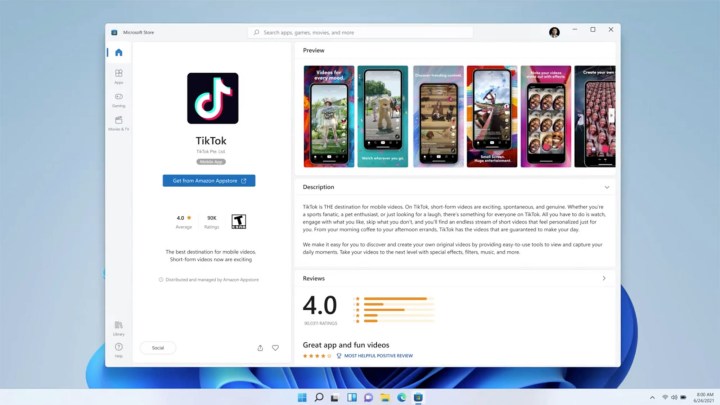At the June 24 Microsoft event, Microsoft confirmed what was long believed to be true. Windows 11 will support Android apps via the Amazon App Store. The apps have the ability to be locally installed and will function without the need for a smartphone, appearing native in your Taskbar and Start Menu.
Microsoft didn’t share many details, but rumors had indicated that the feature could be powered by the Windows Subsystem for Linux. All Android apps that are compatible with Windows 11 will show up in a special section in the Microsoft Store.

Microsoft showcased a screenshot showing apps that can run on Windows 11, and the TikTok app is one of them. The app is able to resize, can be dragged around to a mobile view, and doesn’t appear to run full-screen.
This is similar to the behavior in the Your Phone app, where you are able to sync apps from select Samsung phones through Wi-Fi and the local network. The difference here is that things are now running natively, independent of phones and other devices.

Other than support for Android apps, Microsoft mentioned that the new Microsoft Store on Windows 11 will be more of an open storefront. The store will support all kinds of different apps, including Win32, UWP, and PWA. This means that you’ll be able to find apps like Google Chrome in the Microsoft Store and won’t have to depend on going on the internet to download Win32 apps from other sources.
Microsoft even showcased some new apps in the Microsoft Store in Windows 11. The list includes Disney+, as well as Adobe Creative Cloud. Intel worked together with Microsoft on the technology, and Intel’s bridge technology will bring the apps to life to create a more seamless experience.
As a shot at Apple, Microsoft even announced that apps can have their own commerce engine where developers can take home all the revenue without a cut for Microsoft.
It’s not clear when this feature will come to everyone for testing, but it’s likely to be available once Windows 11 hits general availability in the fall. Microsoft will need to test the feature via the Windows Insider program before launching it to the general public. So be on the lookout for more updates soon.


